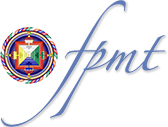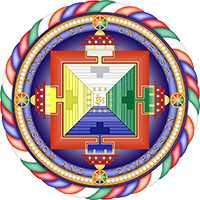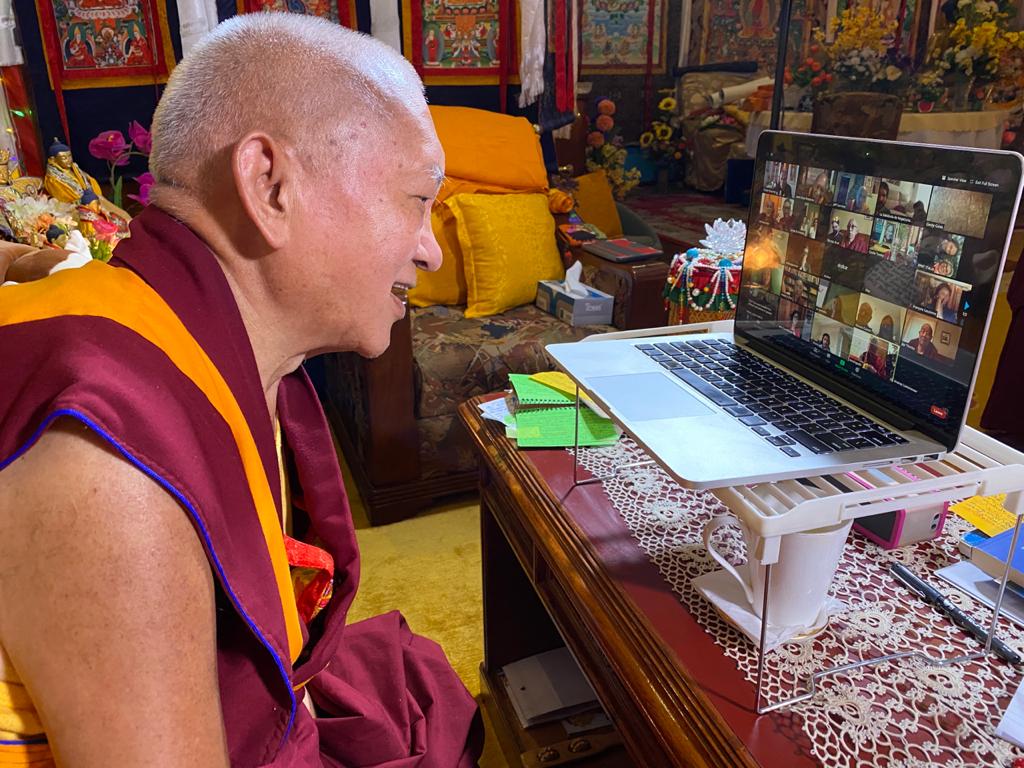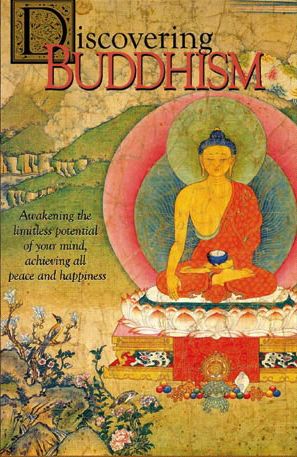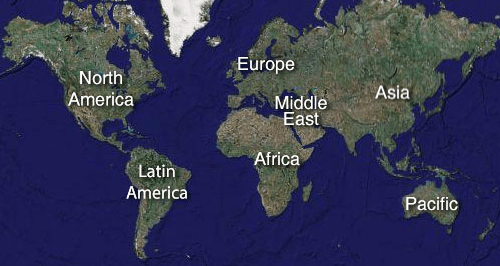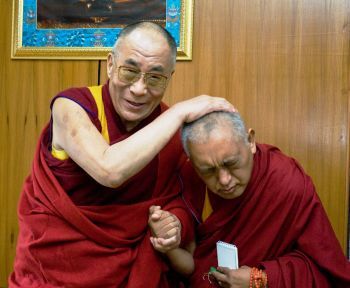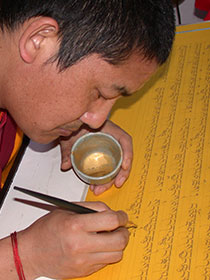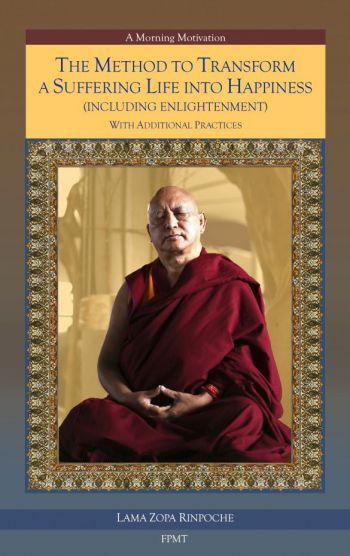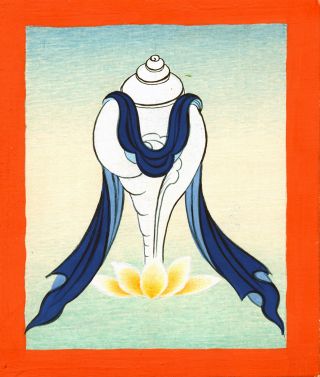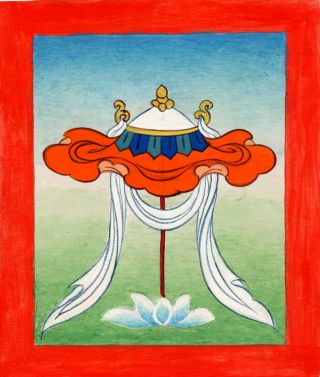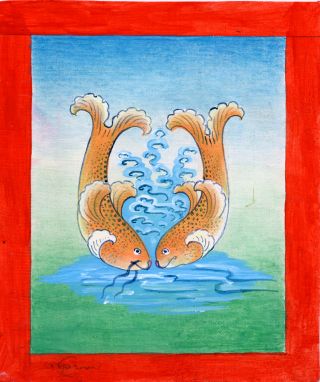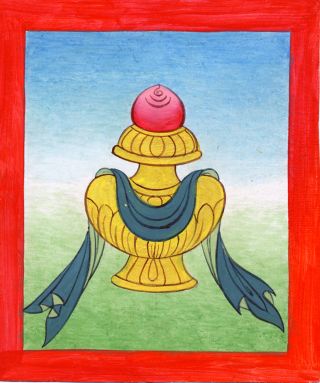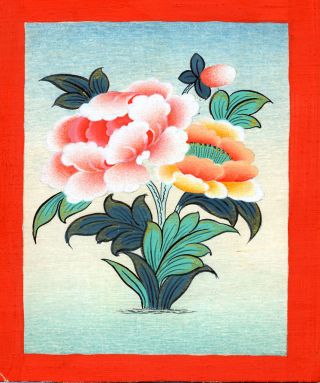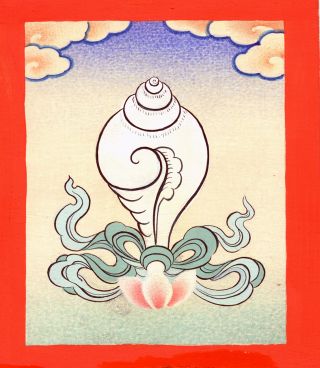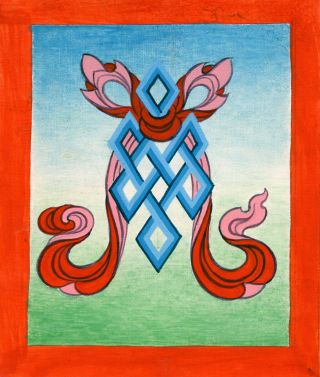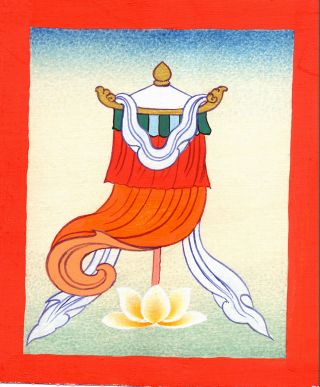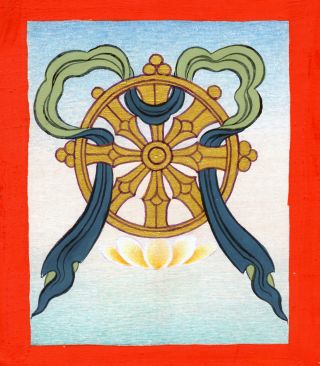- Home
- FPMT Homepage
Foundation for the Preservation of the Mahayana Tradition
The FPMT is an organization devoted to preserving and spreading Mahayana Buddhism worldwide by creating opportunities to listen, reflect, meditate, practice and actualize the unmistaken teachings of the Buddha and based on that experience spreading the Dharma to sentient beings. We provide integrated education through which people’s minds and hearts can be transformed into their highest potential for the benefit of others, inspired by an attitude of universal responsibility and service. We are committed to creating harmonious environments and helping all beings develop their full potential of infinite wisdom and compassion. Our organization is based on the Buddhist tradition of Lama Tsongkhapa of Tibet as taught to us by our founders Lama Thubten Yeshe and Lama Thubten Zopa Rinpoche.
- Willkommen
Die Stiftung zur Erhaltung der Mahayana Tradition (FPMT) ist eine Organisation, die sich weltweit für die Erhaltung und Verbreitung des Mahayana-Buddhismus einsetzt, indem sie Möglichkeiten schafft, den makellosen Lehren des Buddha zuzuhören, über sie zur reflektieren und zu meditieren und auf der Grundlage dieser Erfahrung das Dharma unter den Lebewesen zu verbreiten.
Wir bieten integrierte Schulungswege an, durch denen der Geist und das Herz der Menschen in ihr höchstes Potential verwandelt werden zum Wohl der anderen – inspiriert durch eine Haltung der universellen Verantwortung und dem Wunsch zu dienen. Wir haben uns verpflichtet, harmonische Umgebungen zu schaffen und allen Wesen zu helfen, ihr volles Potenzial unendlicher Weisheit und grenzenlosen Mitgefühls zu verwirklichen.
Unsere Organisation basiert auf der buddhistischen Tradition von Lama Tsongkhapa von Tibet, so wie sie uns von unseren Gründern Lama Thubten Yeshe und Lama Thubten Zopa Rinpoche gelehrt wird.
- Bienvenidos
La Fundación para la preservación de la tradición Mahayana (FPMT) es una organización que se dedica a preservar y difundir el budismo Mahayana en todo el mundo, creando oportunidades para escuchar, reflexionar, meditar, practicar y actualizar las enseñanzas inconfundibles de Buda y en base a esa experiencia difundir el Dharma a los seres.
Proporcionamos una educación integrada a través de la cual las mentes y los corazones de las personas se pueden transformar en su mayor potencial para el beneficio de los demás, inspirados por una actitud de responsabilidad y servicio universales. Estamos comprometidos a crear ambientes armoniosos y ayudar a todos los seres a desarrollar todo su potencial de infinita sabiduría y compasión.
Nuestra organización se basa en la tradición budista de Lama Tsongkhapa del Tíbet como nos lo enseñaron nuestros fundadores Lama Thubten Yeshe y Lama Zopa Rinpoche.
A continuación puede ver una lista de los centros y sus páginas web en su lengua preferida.
- Bienvenue
L’organisation de la FPMT a pour vocation la préservation et la diffusion du bouddhisme du mahayana dans le monde entier. Elle offre l’opportunité d’écouter, de réfléchir, de méditer, de pratiquer et de réaliser les enseignements excellents du Bouddha, pour ensuite transmettre le Dharma à tous les êtres. Nous proposons une formation intégrée grâce à laquelle le cœur et l’esprit de chacun peuvent accomplir leur potentiel le plus élevé pour le bien d’autrui, inspirés par le sens du service et une responsabilité universelle. Nous nous engageons à créer un environnement harmonieux et à aider tous les êtres à épanouir leur potentiel illimité de compassion et de sagesse. Notre organisation s’appuie sur la tradition guéloukpa de Lama Tsongkhapa du Tibet, telle qu’elle a été enseignée par nos fondateurs Lama Thoubtèn Yéshé et Lama Zopa Rinpoché.
Visitez le site de notre Editions Mahayana pour les traductions, conseils et nouvelles du Bureau international en français.
Voici une liste de centres et de leurs sites dans votre langue préférée
- Benvenuto
L’FPMT è un organizzazione il cui scopo è preservare e diffondere il Buddhismo Mahayana nel mondo, creando occasioni di ascolto, riflessione, meditazione e pratica dei perfetti insegnamenti del Buddha, al fine di attualizzare e diffondere il Dharma fra tutti gli esseri senzienti.
Offriamo un’educazione integrata, che può trasformare la mente e i cuori delle persone nel loro massimo potenziale, per il beneficio di tutti gli esseri, ispirati da un’attitudine di responsabilità universale e di servizio.
Il nostro obiettivo è quello di creare contesti armoniosi e aiutare tutti gli esseri a sviluppare in modo completo le proprie potenzialità di infinita saggezza e compassione.
La nostra organizzazione si basa sulla tradizione buddhista di Lama Tsongkhapa del Tibet, così come ci è stata insegnata dai nostri fondatori Lama Thubten Yeshe e Lama Zopa Rinpoche.
Di seguito potete trovare un elenco dei centri e dei loro siti nella lingua da voi prescelta.
- 欢迎 / 歡迎
简体中文
“护持大乘法脉基金会”( 英文简称:FPMT。全名:Foundation for the Preservation of the Mahayana Tradition) 是一个致力于护持和弘扬大乘佛法的国际佛教组织。我们提供听闻,思维,禅修,修行和实证佛陀无误教法的机会,以便让一切众生都能够享受佛法的指引和滋润。
我们全力创造和谐融洽的环境, 为人们提供解行并重的完整佛法教育,以便启发内在的环宇悲心及责任心,并开发内心所蕴藏的巨大潜能 — 无限的智慧与悲心 — 以便利益和服务一切有情。
FPMT的创办人是图腾耶喜喇嘛和喇嘛梭巴仁波切。我们所修习的是由两位上师所教导的,西藏喀巴大师的佛法传承。
繁體中文
護持大乘法脈基金會”( 英文簡稱:FPMT。全名:Found
ation for the Preservation of the Mahayana Tradition ) 是一個致力於護持和弘揚大乘佛法的國際佛教組織。我們提供聽聞, 思維,禪修,修行和實證佛陀無誤教法的機會,以便讓一切眾生都能 夠享受佛法的指引和滋潤。 我們全力創造和諧融洽的環境,
為人們提供解行並重的完整佛法教育,以便啟發內在的環宇悲心及責 任心,並開發內心所蘊藏的巨大潛能 — 無限的智慧與悲心 – – 以便利益和服務一切有情。 FPMT的創辦人是圖騰耶喜喇嘛和喇嘛梭巴仁波切。
我們所修習的是由兩位上師所教導的,西藏喀巴大師的佛法傳承。 察看道场信息:
- FPMT Homepage
- News/Media
-
- Study & Practice
-
-
- About FPMT Education Services
- Latest News
- Programs
- New to Buddhism?
- Buddhist Mind Science: Activating Your Potential
- Heart Advice for Death and Dying
- Discovering Buddhism
- Living in the Path
- Exploring Buddhism
- FPMT Basic Program
- FPMT Masters Program
- FPMT In-Depth Meditation Training
- Maitripa College
- Lotsawa Rinchen Zangpo Translator Program
- Universal Education for Compassion & Wisdom
- Online Learning Center
-
- Prayers & Practice Materials
- Overview of Prayers & Practices
- Full Catalogue of Prayers & Practice Materials
- Explore Popular Topics
- Benefiting Animals
- Chenrezig Resources
- Death & Dying Resources
- Lama Chopa (Guru Puja)
- Lama Zopa Rinpoche: Compendium of Precious Instructions
- Lama Zopa Rinpoche: Life Practice Advice
- Lama Zopa Rinpoche Practice Series
- Lamrim Resources
- Mantras
- Prayer Book Updates
- Purification Practices
- Sutras
- Thought Transformation (Lojong)
- Audio Materials
- Dharma Dates - Tibetan Calendar
- Translation Services
- Publishing Services
- Ways to Offer Support
- Prayers & Practice Materials
-
- Teachings and Advice
- Find Teachings and Advice
- Lama Zopa Rinpoche Advice Page
- Lama Zopa Rinpoche: Compendium of Precious Instructions
- Lama Zopa Rinpoche Video Teachings
- ༧སྐྱབས་རྗེ་བཟོད་པ་རིན་པོ་ཆེ་མཆོག་ནས་སྩལ་བའི་བཀའ་སློབ་བརྙན་འཕྲིན།
- Podcasts
- Lama Yeshe Wisdom Archive
- Buddhism FAQ
- Dharma for Young People
- Resources on Holy Objects
- Teachings and Advice
-
-
*If a menu item has a submenu clicking once will expand the menu clicking twice will open the page.
-
-
- Centers
-
- Teachers
-
- Projects
-
-
-
-
*If a menu item has a submenu clicking once will expand the menu clicking twice will open the page.
-
-
- FPMT
-
-
-
-
-
When others insult, rebuke and speak unpleasant words to us, although an intolerable pain arises like a thorn at the heart, if we comprehend the teachings then we can recognize the essenceless nature of these words which resemble an echo. So just as when an inanimate object is scolded, we will experience not the slightest mental turmoil.
His Holiness the Dalai Lama
-
-
-
- Shop
-
-
-
The Foundation Store is FPMT’s online shop and features a vast selection of Buddhist study and practice materials written or recommended by our lineage gurus. These items include homestudy programs, prayers and practices in PDF or eBook format, materials for children, and other resources to support practitioners.
Items displayed in the shop are made available for Dharma practice and educational purposes, and never for the purpose of profiting from their sale. Please read FPMT Foundation Store Policy Regarding Dharma Items for more information.
-
-
Lama Zopa Rinpoche News and Advice
26
The Eight Auspicious Signs
Translated with commentary by Lama Zopa Rinpoche; paintings of the eight auspicious signs by Gelek Sherpa.
Probably many of us do not know how important these eight auspicious signs are and how they affect our lives. They can be used externally to help with one’s own success as well as with the FPMT organization to be successful in benefiting others and working for the teachings of the Buddha. Putting these eight auspicious signs around everywhere, outside and also inside the rooms, makes things very auspicious. It is not necessary to put all eight together, and they don’t all need to be in the same place. They can be placed separately at different locations, but you should have all of them.
The eight auspicious signs are the
- umbrella
- yellow fish
- vase
- lotus
- white conch shell
- glorious peu1
- banner
- Dharma chakra
Here is the meaning of these eight auspicious signs according to my root guru, His Holiness Trijang Dorje Chang’s explanation.2
Wherever these eight auspicious signs exist, there will be the dependent arising of increasing the virtue of auspiciousness.
Colophon: Dictated by Kyabje Lama Zopa Rinpoche to Ven. Sarah Thresher at Root Institute, Bodhgaya, India, February 4, 2014. Edited with the help of Losang Hursthouse.
1. Skt. Srivatsa. Rinpoche has not translated this because it is not clear exactly how it should be translated. It is usually referred to as the “unending knot” but this is not the literal meaning of the words.
- Tagged: eight auspicious symbols, lama zopa rinpoche
- 0
21
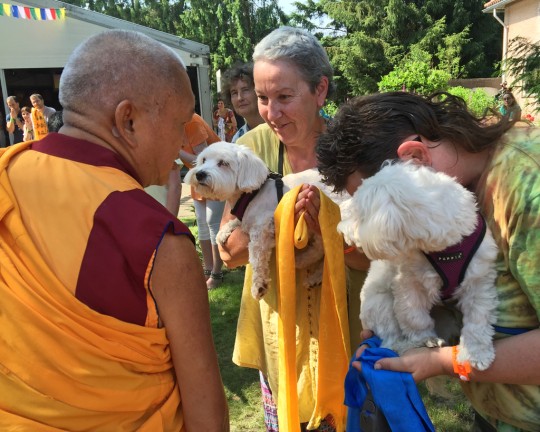
Lama Zopa Rinpoche blessing two dogs on the way to teaching, Maitreya Instituut, Loenen, Netherlands, July 2015. Photo by Ven. Roger Kunsang.
Lama Zopa Rinpoche gave this advice while in New York City in July 2016.
I have heard that you have to take indoor dogs out three times a day, so I thought that this gives you an unbelievable, incredible opportunity to help them.
By not harming and practicing morality toward even one sentient being, including these dogs, you can attain the state of the happy transmigratory beings. By not harming and practicing concentration and wisdom, even with dogs, you can achieve the happiness that is free from samsaric suffering. And by generating compassion, bodhichitta, you can attain buddhahood, ultimate happiness—the completion of all realizations and total freedom from all obscurations—through depending on these sentient beings, these dogs.
Another way to understand this is that by cherishing these dogs you can receive hundreds of thousands of happy rebirths and so forth in future lives. By cherishing these sentient beings, these dogs, you can achieve ultimate happiness forever. By cherishing these sentient being dogs you can achieve the peerless happiness of buddhahood. Not only that, but you also achieve the numberless past happinesses that you already have received since beginningless rebirths as well as your present happiness and all future happiness, including full enlightenment.
You may find this difficult to believe but it is logical. Your three time happinesses come from your good karma and your virtuous mind is the action of the Buddha. There are two actions of Buddha: one is within us sentient beings; the other is possessed only by the Buddha’s holy mind. Buddha comes from the bodhisattva, the bodhisattva comes from bodhichitta and bodhichitta comes from great compassion, which embraces numberless sentient beings, not leaving out even one: the numberless hell beings, pretas, animals, humans, asuras and suras.
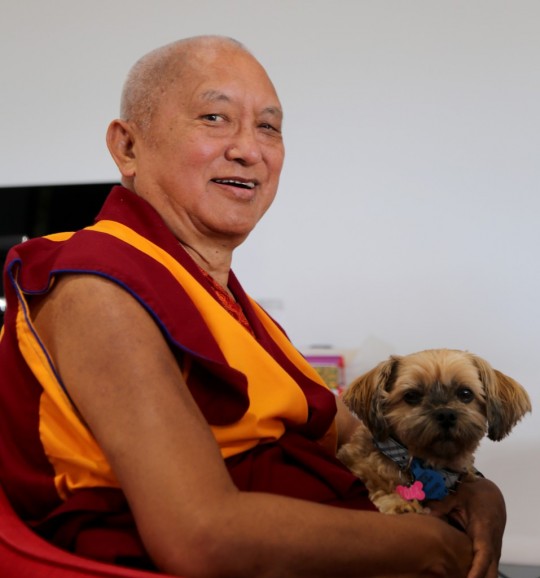
Lama Zopa Rinpoche and a cute canine friend, Adelaide, Australia, May 2015. Photo by Ven. Thubten Kunsang.
So this is how you receive all your past, present and future happiness from each and every sentient being, which includes the dogs that you take out for a walk three times a day. So these dogs are most precious—think like this—most precious, most kind, most dear and wish-fulfilling for you.
The next thing to understand is that these sentient beings are objects to not be harmed. They are to be cherished by you, to be taken care of with your body, speech and mind; you are to serve them.
One more thing to understand is that you have been experiencing the sufferings of the six realms numberless times from beginningless rebirths and you will have to experience them again without end, over and over again, if you don’t practice Dharma.
At this time you have received the impossible, a precious human life. And not only have you received a perfect human rebirth but you have also met the Mahayana sutra and tantra teachings, so not only can you achieve liberation from samsara; through having met the Mahayana sutra teachings you can achieve full enlightenment for sentient beings. Furthermore, through having met the Mahayana tantric teachings you can achieve enlightenment in just one lifetime—you don’t need the three countless great eons to collect merit and purify obscurations that you do when practicing sutra. Finally, you have met maha-anuttara yoga tantra, through which you can achieve the unified state of enlightenment in one brief lifetime of this degenerate age. So this time you are most fortunate.
Now, sentient beings who have received a perfect human rebirth like yours are extremely rare. Most other sentient beings haven’t even met the Buddha, Dharma and Sangha, which means they will have to experience samsaric suffering endlessly. If you really think about it you won’t be able to stand it, not even for a second, without wanting to free them from samsara. And not only that—they have been experiencing such suffering from beginningless, numberless lives.
Now the dogs are exactly the same. You have to think about this. These dogs have been experiencing suffering since beginningless lifetimes and will continue to do so without end. You can’t stand leaving them in that state of suffering for even one second.
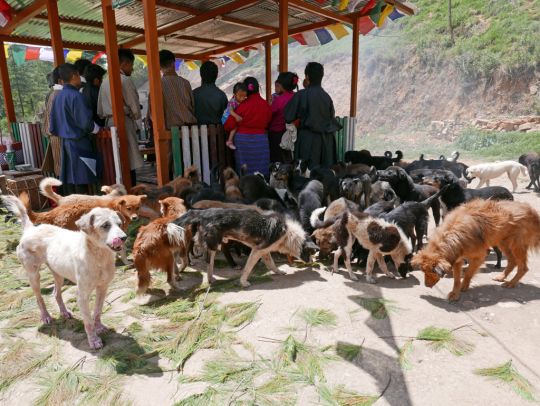
Dogs gathered at Jangsa Animal Saving Trust while Lama Zopa Rinpoche gives blessings, Bhutan, June 2016. Photo by Ven. Roger Kunsang.
So when you take your dogs out you should recite mostly OM MANI PADME HUM and the Maitreya Buddha mantras so that the dogs can hear them. That purifies their negative karma collected since beginningless time and allows them to collect merit. It purifies their mental continuum and brings them to enlightenment in the future: by meeting the Dharma they receive a higher rebirth, develop understanding through practicing Dharma and eventually achieve enlightenment. It is as if you are giving a wish-granting jewel to the dogs. Just by chanting you help them so much.
You can also recite the Medicine Buddha mantra, which helps them to not be reborn in the lower realms ever again, and the short Namgyälma mantra, which makes it impossible for them to be reborn in lower realms; this will be their last rebirth as an animal. Another mantra you can recite is OM PÄDMO USHNISHA VIMALE HUM PHAT. When you take the dogs out, chant so that they can hear it.
At the beginning, generate bodhichitta by thinking, “The purpose of my life is not simply to achieve the happiness of this life; nor is it to achieve either temporary or ultimate happiness for myself alone. The purpose of my life is to achieve enlightenment in order to free all sentient beings from the oceans of samsaric suffering and bring them to enlightenment. Therefore I must achieve the state of omniscience. Therefore I am going to recite these mantras for the dogs and even others who are passing by.”
You can recite the mantras by chanting them like a song. Others might then just see you as happy person walking along with your dogs. If people ask what you’re singing you can say that you’re chanting mantras. It depends on who asks.
Scribed by Ven. Roger Kunsang, July 2016, New York, United States. Edited by Nicholas Ribush.
Find the mantras Lama Zopa Rinpoche recommends above on FPMT Education Services’ mantra resource page on FPMT.org.
Lama Zopa Rinpoche is the spiritual director of the Foundation for the Preservation of Mahayana Tradition (FPMT), a Tibetan Buddhist organization dedicated to the transmission of the Mahayana Buddhist tradition and values worldwide through teaching, meditation and community service.
- Tagged: advice from lama zopa rinpoche, animals, dogs
- 0
14
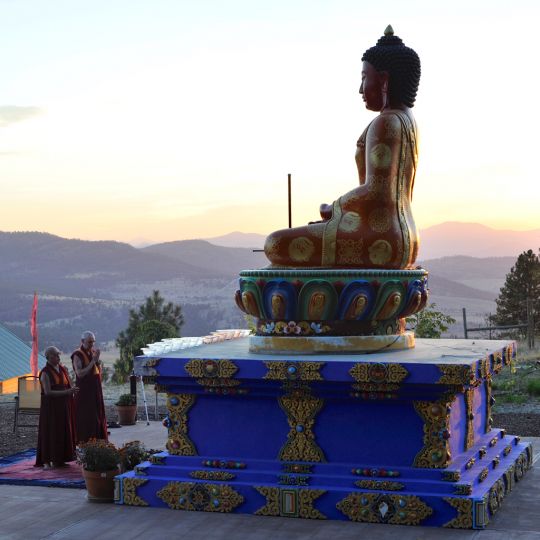
Lama Zopa Rinpoche, Ven. Roger Kunsang and Buddha Amitabha statue at Buddha Amitabha Pure Land, Washington, US, 2016. Photo by Ven. Lobsang Sherab.
“Every time you look at holy objects—pictures of the Buddha, statues, scriptures, stupas—they plant the seed of liberation and enlightenment in your mental continuum. So every time you look at them they purify your mind. They plant the seed of enlightenment, which includes all the causes to achieve enlightenment,” Lama Zopa Rinpoche teaches in the advice “Why Holy Objects are Precious and Wish-fulfilling.”
“How? When you look at them they plant a seed or positive imprint on your mental continuum so that later when you meet Buddhadharma, either in this life or in future lives, you are able to understand the words and the meaning of the teachings. From that, you are able to practice the meaning of the Dharma you have understood, which causes you to cease the gross and subtle defilements by actualizing the path and then your mental continuum becomes omniscient mind. This is what is meant when we say that by seeing holy objects it plants the seed of enlightenment on the mind—it contains the whole path from guru devotion and the three principals up to the two stages of tantra and enlightenment. Seeing holy objects makes us actualize all of this as a result. This is the effect we get from seeing them and this is how they cause us to achieve enlightenment.
“Every time we see holy objects it purifies so much negative karma, so many defilements. This is because of the power of the holy object. Holy objects have so much power. It’s like an atomic bomb—even though it is small it can bring so much harm and cause so much destruction. That example is negative but what I am saying is that the material has power, like electricity. The material of an atomic bomb has the power to harm and destroy the world. The material of holy objects—statues, scriptures and stupas—has the power to affect our mind, to leave a positive imprint. …”
Read the entire advice from Rinpoche, “Why Holy Objects are Precious and Wish-fulfilling,” on FPMT.org:
https://fpmt.org/wp-content/uploads/teachers/zopa/advice/ImportanceofHolyObjects.pdf
More information, photos and updates about FPMT spiritual director Lama Zopa Rinpoche can be found on Rinpoche’s webpage on FPMT.org. If you’d like to receive news of Lama Zopa Rinpoche and FPMT via email, sign up to FPMT News.
- Tagged: holy objects, lama zopa rinpoche
- 0
12
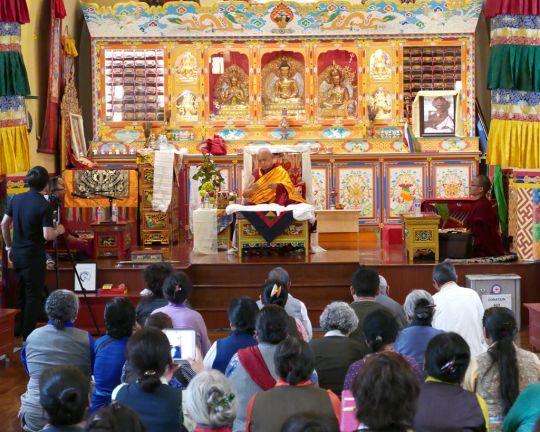
Lama Zopa Rinpoche giving advice to the elder Sherpa community in New York City, US, July 2016. Photo by Ven. Roger Kunsang.
On August 10, Lama Zopa Rinpoche had lunch with and gave a public talk and oral transmission of the Medicine Buddha mantra to the members of the Himalayan Elders Project during his 2016 visit to New York City. After the teachings, Rinpoche personally blessed each participant.
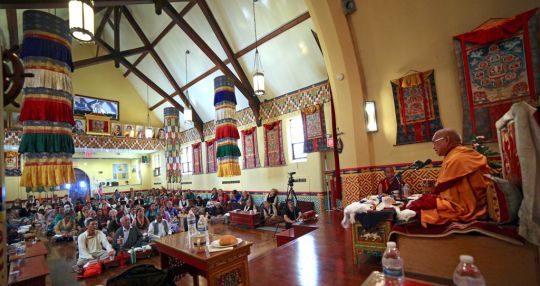
Lama Zopa Rinpoche at an event organized by the Himalayan Elders Project in New York City, US, July 2016. Photo by Ven. Lobsang Sherab.
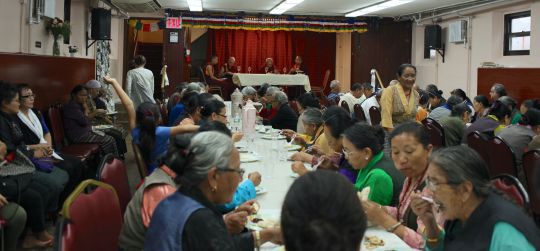
Lama Zopa Rinpoche having lunch with the members of he Himalayan Elders Project, New York, US, August 2016. Photo by Ven. Lobsang Sherab.
The Himalayan Elders Project “is a community initiative which provides time and space for our seniors to gather, practice Dharma, socialize, share life experiences, enjoy community connectedness and enjoy a renewed sense of independence.”
Watch “Kyabje Lama Zopa Rinpoche’s visit to the Himalayan Elders Project” on YouTube (Tibetan):
https://youtu.be/kjz-QlGn2yU
More information, photos and updates about FPMT spiritual director Lama Zopa Rinpoche can be found on Rinpoche’s webpage on FPMT.org. If you’d like to receive news of Lama Zopa Rinpoche and FPMT via email, sign up to FPMT News.
7
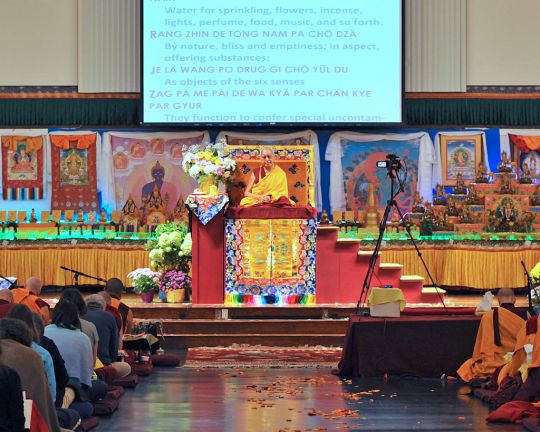
Lama Zopa Rinpoche teaching at Light of the Path retreat, August 2016. Photo by Ven. Lobsang Sherab.
During the recent Light of the Path retreat, Lama Zopa Rinpoche dictated this advice and had it distributed to all participants. Rinpoche also wanted it shared with people offering service at FPMT centers, projects and service as well as with all beings everywhere.
Freeing them from the oceans of samsaric suffering and bringing them to the peerless happiness of buddhahood—the total cessation of all obscurations and the completion of all realizations
It all depends on your motivation. If you are motivated by the self-cherishing thought, concern for only your own happiness, your own power, and have no concern for others’ happiness, your motivation is coming from your delusions, such as attachment, anger, ignorance and so forth. Then your actions of body, speech and mind will manifest as ugly, unpeaceful and hurtful to others and, as a result, others will react in an ugly, unpeaceful and hurtful way with their body, speech and mind; for example, by getting angry at you. It is like a circle. How you treat others and how they treat you in return is similar, with such negative thoughts and actions. You have to be fully aware of that in your everyday life.
Generally you have to know that you are responsible to not cause others suffering but to bring them happiness. Even if you don’t think of practicing Dharma, to at least be a good human being you need to know this. You are totally responsible as to whether you bring happiness or suffering to others. It is totally dependent on your motivation and how you treat others; it’s up to you whether your motivation is pure or not. Even just to be a good person, a generous human being, you have to know that. If you have a bad motivation and your actions of body, speech and mind are harmful for others, you make others create negative karma when they retaliate by harming you in return. By harming others you therefore cause them to be reborn in the lower realms; to lose their human rebirth and take a lower rebirth and suffer for eons. Can you imagine yourself being in the lower realms? That’s where you’re causing other sentient beings to go and have unhappiness instead of enjoyment.
In the Bodhicaryavatara, Shantideva said,
Smiling at others (showing them a pleasant face)
Causes you to have a beautiful body in future lives.
So you don’t need to have plastic surgery or other expensive procedures. Your positive mind can give you a pleasant, happy, smiling face and a peaceful, not a political, smile. Others will feel this and also become like that, having a good heart and being smiling and happy. Thus you always have to be aware of how others act toward you, positive or negative. It is totally dependent upon your own mind.
The morning motivation, the Method to Transform a Suffering Life into Happiness, contains the details for keeping your mind positive. If you do this motivation every morning you will always act positively toward others for the rest of the day.
However, first think that all your past, present and future happiness, including enlightenment, is received from every sentient being. You receive everything through the kindness of every sentient being, which includes even those people you don’t like—those who make you angry merely upon sight or when you hear their voice. It is so important to understand this evolution. Therefore you should hold all sentient beings in your heart and feel that they are most precious, most kind, most dear and wish fulfilling for you. Then there will be no way for your mind to get angry or to generate ignorance, attachment, selfishness or self-cherishing and, therefore, no way for you to harm others. You absolutely dare not harm others, even in the slightest way.
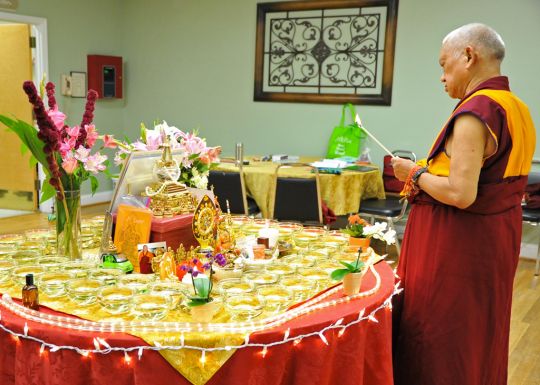
Lama Zopa Rinpoche during Light of the Path, Black Mountain, North Carolina, US, August 2016. Photo by Ven. Lobsang Sherab.
Even Buddha, Dharma and Sangha—in whom you always take refuge to be free from the lower realms and get higher rebirths; to be free from samsara and achieve liberation, lower nirvana; and to be free from the self-cherishing thought and achieve the peerless happiness of total cessation of all mistakes and completion of all realizations—even this Buddha, Dharma, Sangha in whom you take refuge and who give you all this happiness come from sentient beings, including the ones that are angry at or who harm you, who speak to you hurtfully and so forth, sentient beings that you don’t like. Therefore they are all so precious, unbelievably precious to you. On top of that, they have been your kind mother from beginningless rebirths and even now; it’s unbelievable. So you have to think about this and the dependent arising I mentioned before as well. Think about these two things—it makes not harming and only benefiting others very deep. In that way your life will be only of benefit.
The conclusion is that to be free from the suffering of samsara as quickly as possible and to achieve peerless happiness, the total cessation of all mistakes and the completion of all realizations, then with this thought, smile at others, respect them with your body, speech and mind and speak to them in a nice, respectful way.
Treat people the way you’d like them to treat you: with respect, nice speech and smiles that come from a good heart. If you do that, then, as a result of karma, many others will treat you in the same way. Otherwise others will be angry with you, speak to you rudely and hurtfully, and harm you with the actions of their body, speech and mind.
So here I am mentioning how sentient beings are most kind, most precious, most dear and wish fulfilling. Then you can really enjoy life with them, bring them much inner happiness, and in your own mind you will also enjoy much inner happiness, and that will make them happy too.
His Holiness the Dalai Lama respects even ordinary people. He bends down in respect; Lama Yeshe also did this. Even when he heard about someone’s mistakes, some problems with monks and so forth, when he later met them he showed respect. Like that, this is an incredible practice, rather than feeling pride, showing arrogance and putting others down. Most people might do that, but in my experience, Lama Yeshe never did.
Behaving like this is a great, great, great responsibility of the center director, secretary, board members, office manager, treasurer, spiritual program coordinator, bookshop manager and so forth. Especially these people, but in general, this is for everybody. It’s a question of karma, to not create negative karma and to create good karma. This not only makes you happy but also makes other sentient beings happy. So even with your speech you can make so many sentient beings happy.
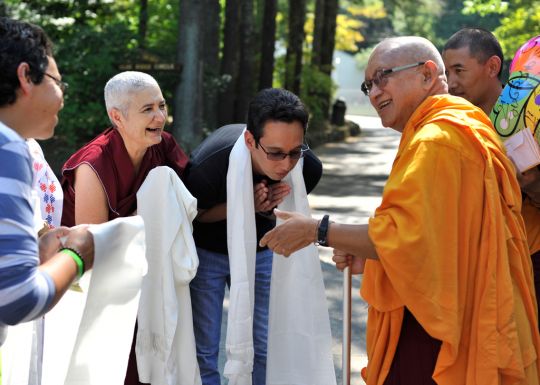
Light of the Path retreat, Black Mountain, North Carolina, US, August 2016. Photo by Ven. Lobsang Sherab.
You have to be aware that there are very powerful mantras given to us by the Buddha to make our speech very powerful and beneficial for sentient beings. If in the morning you recite the Exalted Stainless Beam Totally Pure Light mantra after blessing your speech, then anybody who simply hears your voice that day, animals or people—whether they hear you singing or in any other way (not necessarily reciting mantras)—is purified of the five heavy negative karmas without break.
The Exalted Stainless Beam Totally Pure Light mantra:
NAMA NAWA NAWA TII NÄN / TATHAAGATA GANG GAA NAM
DIIWAA LUKAA NÄN / KOTINI YUTA SHATA SAHA SRAA NÄN /
OM BOBORI / TSARI NI* TSARI / MORI GOLI TSALA WAARI
SWAAHAA (recite this a few times) [*indicates a high tone]
Then if you also recite one thousand OM MANI PADME HUM mantras every morning, seven generations of your family will not be reborn in the lower realms. Moreover, when other sentient beings see you, even in places where there are many other people, just by seeing you their negative karma will be purified. Also, when you die and your body is cremated, if the smoke from the fire touches any sentient being, human, insect or whatever, it purifies their negative karma and helps them not be reborn in the lower realms.
From Kyabje Khunu Lama Rinpoche’s Verses in Praise of Bodhicitta,
That which benefits lower sentient beings is bodhichitta.
That which benefits middling sentient beings is bodhichitta.
That which benefits sublime sentient beings is bodhichitta.
Isn’t bodhichitta of benefit to all?
If you want to look, look with bodhichitta.
If you want to eat, eat with bodhichitta.
If you want to speak, speak with bodhichitta.
If you want to examine, examine with bodhichitta.
If you desire happiness for transmigratory beings equaling the sky,
Then cherish bodhichitta.
If you desire to benefit transmigratory beings equaling the sky,
Then cherish bodhichitta.
Bodhichitta eliminates pain.
Bodhichitta destroys harm.
Bodhichitta eliminates unhappiness.
Bodhichitta dispels fear.
Scribe: Holly Ansett, 17 August 2016, Black Mountain, North Carolina, US. Edited by Nicholas Ribush.
Lama Zopa Rinpoche is the spiritual director of the Foundation for the Preservation of Mahayana Tradition (FPMT), a Tibetan Buddhist organization dedicated to the transmission of the Mahayana Buddhist tradition and values worldwide through teaching, meditation and community service.
- Tagged: advice from lama zopa rinpoche, lama zopa rinpoche, practice, the method to transform a suffering life into happiness
- 0
5
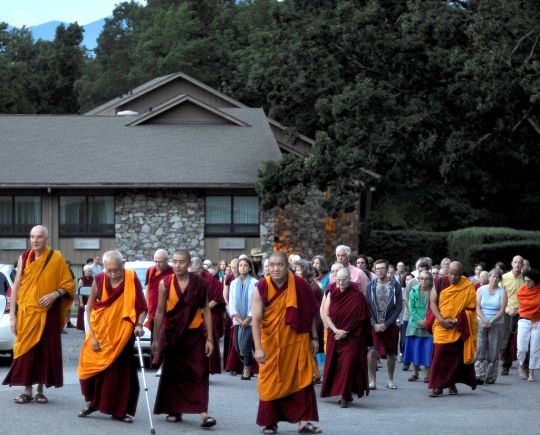
Lama Zopa Rinpoche leading walking meditation at Light of the Path, Black Mountain, North Carolina, US, August 2016. Photo by Ven. Lobsang Sherab.
On August 17, Ven. Roger Kunsang shared on Lama Zopa Rinpoche’s Twitter page this very brief teaching from Lama Zopa Rinpoche:
Walking meditation … Every step, every breath brings us closer to death … Only thing to do .. Practice Dharma!
Ven. Roger Kunsang, Lama Zopa Rinpoche’s assistant and CEO of FPMT Inc., shares Lama Zopa Rinpoche’s recent pith sayings and activities on Rinpoche’s Twitter page.
More information, photos and updates about FPMT spiritual director Lama Zopa Rinpoche can be found on Rinpoche’s webpage. If you’d like to receive news of Lama Zopa Rinpoche via email, sign up to receive FPMT News.
- Tagged: lama zopa rinpoche, twitter
- 0
31
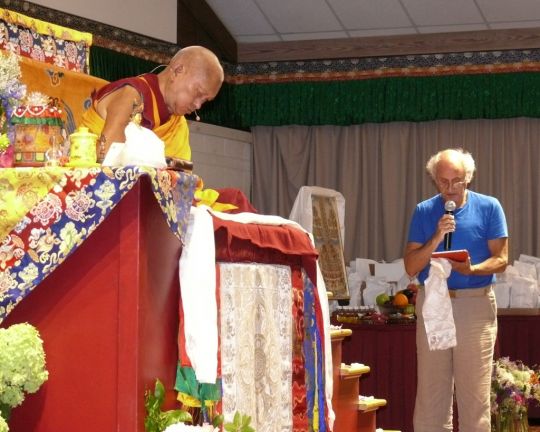
Lama Zopa Rinpoche with Nick Ribush, director of Lama Yeshe Wisdom Archive, reading praise he wrote for Rinpoche, Light of the Path retreat, North Carolina, US, August 2016. Photo courtesy of LYWA.
At the conclusion of the Light of the Path retreat with Lama Zopa Rinpoche, Nick Ribush composed and delivered a praise of Rinpoche that also requested for him to live a long life. Nick is a long-time student of Lama Zopa Rinpoche and serves as the director of the Lama Yeshe Wisdom Archive, which published the praise in its August E-letter. We share the praise here:
WE LOVE YOU, RINPOCHE
Rinpoche, we love you.
Out of your unfathomable, unbearable great compassion
You have manifested out of the infinite vastness of the dharmakaya
To guide those fortunate beings who have that rarest of rare karmas to meet you.
You appear in an ordinary body but are, in reality, all the buddhas of the past, present and future.
Yet you are kinder than all tathagatas together.
Please, please live long.
Rinpoche, we love you.
Because of your impeccable guidance in our previous lives,
We have been able to crawl out of the lower realms for this brief, lightning flash
Of a perfect human rebirth, where you can again teach us
How to extract its essence and make it meaningful in the three ways
By revealing the precious teachings on the nature of the mind.
Please, please live long.
Rinpoche, we love you.
If it were not for your teachings we would soon again
Find ourselves in the hell, hungry ghost or animal realms.
Even though death is definite and the time of death uncertain,
You refuse to let us go back down by explaining the inconceivable suffering experienced there
And teaching us mantras that preclude lower rebirth.
You are a perfect refuge.
You give us protection and are an immaculate example of how to follow karma
And at least find rebirth as a happy transmigratory being.
Please, please live long.
Rinpoche, we love you.
Your brilliant explanations of all samsaric suffering
Allow us to deeply feel the horrors of cyclic existence and develop renunciation.
Your profound explanations of the four noble truths,
The twelve links and the emptiness of all phenomena
Allow us to clearly see reality, shake off the chains of conditioned existence
And escape this prison of torture and death forever.
Please, please live long.
Rinpoche, we love you.
Bodhicitta is the secret of the mind.
You elucidate its importance over and over again, until perhaps we finally get it.
You describe in great detail the kindness of each and every sentient being
And how intolerable is the suffering they constantly undergo.
They all have been our mother and the happiness of each is far more important than our own.
Thus you show us how to develop the mind that strives day and night for their enlightenment,
Please, please live long.
Rinpoche, we love you.
That mother sentient beings have to suffer for even one second more is
So unacceptable that we ourselves must attain buddhahood right now.
Fortunately, by some miracle we have found you, Vajradhara, the peerless vajra master,
And the incomparable Mahayana tantra. In this degenerate age
You give us initiations, vows and commentaries
So that in this brief lifetime, we can become buddhas ourselves.
Please, please live long.
Rinpoche, we love you.
Never stop leading us through the stages of the path to enlightenment.
Never abandon us to the dreaded sufferings of samsara.
Never leave us in the perfect peace of nirvana.
Always keep us close until we too enter your enlightened realm.
Please, please live long.
Please, please live long.
Please, please live long.
Colophon: Written in haste from the bottom of the barrel by the ignorant Nicholas Ribush for the concluding Guru Puja at the Light of the Path retreat, Black Mountain, North Carolina, August 2016, at the request of Mer Stafford.
Many resources and materials have been developed from the Light of the Path teachings, which you can find online:
- Recorded video, audio and transcripts of the Light of the Path 2016 teachings will be posted on FPMT.org as they become available.
- All teachings from the 2009, 2010 and 2014 are available on the FPMT Online Learning Center.
- Together with many additional resources, the Living in the Path online program has been created from the Light of the Path retreat teachings. Organized into structured modules, you will find this program on the FPMT Online Learning Center.
More information, photos and updates about FPMT spiritual director Lama Zopa Rinpoche can be found on Rinpoche’s webpage on FPMT.org. If you’d like to receive news of Lama Zopa Rinpoche and FPMT via email, sign up to FPMT News.
- Tagged: lama yeshe wisdom archive, lama zopa rinpoche, light of the path, light of the path 2016, nicholas ribush, praise for lama zopa rinpoche
- 0
29
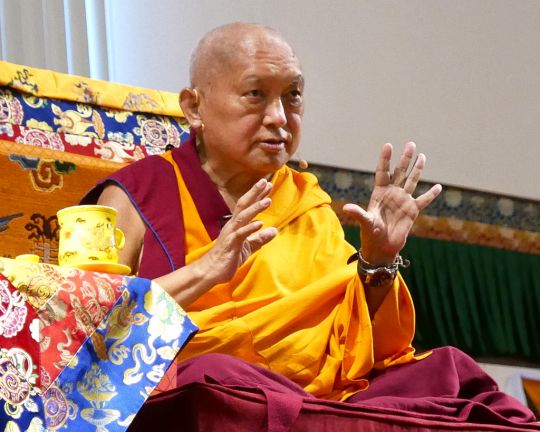
Lama Zopa Rinpoche teaching at Light of the Path retreat, North Carolina, US, August 2016. Photo by Ven. Roger Kunsang.
“If you can find a reason for why you’re feeling depressed, you can try to use that situation or those conditions as the basis for meditation to overcome the depression. But if you can find no obvious reason, the best thing you can do is to use your depression to develop bodhichitta,” Lama Zopa Rinpoche advises in talk given at Vajrapani Institute in 1997 and published by the Lama Yeshe Wisdom Archive in 2010.
“For example, in the Guru Puja there’s a verse that reads,
Please bless me to realize that the chronic disease of self-cherishing, the thought cherishing the I, is the cause of all my undesired sufferings and to destroy this great demon of self-cherishing by blaming and harboring a grudge against it.
“Recite this, and also the next verse, which reads,
Please bless me to see that cherishing all mother sentient beings and wanting to lead them to bliss is the door to infinite good qualities and to cherish them more than my life, even should they rise up as enemies against me.
“It is very, very good to recite these verses in daily life in general and when you’re feeling depressed in particular. Use your depression to practice the meaning of these two verses.
“As the Guru Puja says, cherishing the I is the door to all suffering and problems. Since all the problems and obstacles to happiness you encounter come from cherishing your I – in other words, from your I itself – you should renounce your I forever; give it up completely. And since all happiness comes from bodhichitta, cherishing others, every good thing, every happiness, including enlightenment, comes from others. Therefore, sentient beings are all that you should ever cherish.
“Furthermore, since every happiness and perfection, including all realizations up to enlightenment, comes from other sentient beings, you have to repay their kindness; you have to help them.
“Giving sentient beings wealth is not the best way of repaying their kindness. They have all been billionaires, even wheel-turning kings owning entire universes, in previous lives, but despite having had all those riches numberless times, they are still not free from the suffering of samsara. Giving them wealth is not the best way to repay their kindness.
“The best way to help others is to direct your mind towards Dharma, to practice lam-rim. To transform your mind from ignorance, ego and attachment to samsara into the positive, pure thoughts of the path to enlightenment. By actualizing the realizations of the path yourself, you can liberate others from suffering without much difficulty. By trying to develop bodhichitta, you can make your life worthwhile in the best possible way. …”
You can read this advice on working with depression in its entirety in the Lama Yeshe Wisdom Archive October 2010 Eletter:
https://www.lamayeshe.com/article/e-letter-no-89-october-2010
More information, photos and updates about FPMT spiritual director Lama Zopa Rinpoche can be found on Rinpoche’s webpage on FPMT.org. If you’d like to receive news of Lama Zopa Rinpoche and FPMT via email, sign up to FPMT News.
- Tagged: depression, lama zopa rinpoche
- 0
26
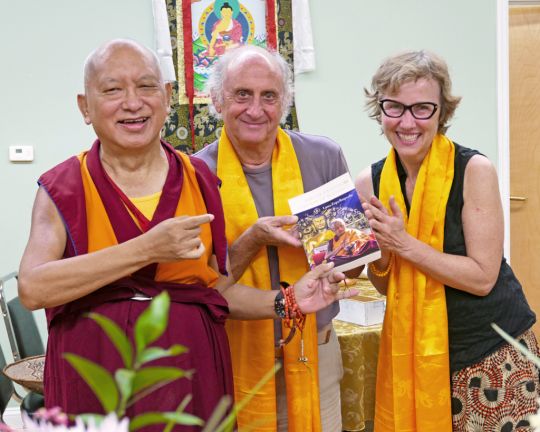
Lama Zopa Rinpoche with Nicholas Ribush and Wendy Cook of the Lama Yeshe Wisdom Archive, Black Mountain, North Carolina, US, August 2016. Nick and Wendy are presenting Rinpoche with a copy of Rinpoche’s new book “Sun of Devotion, Stream of Blessings,” just published by the Archive. Photo by Ven. Roger Kunsang.
“If we do some profound scientific analysis, some inner scientific analysis, we can see how much we believe in this totally real I that actually does not exist. It appears to be real from its own side, we believe it to be real one hundred percent, but it is not there. By doing this inner scientific analysis, this meditation, we can come to see this very subtle point, the nonexistence of this ‘real’ I,” Lama Zopa Rinpoche teaches in the new book Sun of Devotion, Stream of Blessings, recently published by the Lama Yeshe Wisdom Archive.
“Otherwise, without checking, because of our belief in its reality there are all the worries, all the fears. Because of this this wrong projection, when somebody passes us with her nose in the air, looking down at as disdainfully, it hurts so much! Or when we do a good deed for somebody, such as giving a thirsty person a glass of water, and we don’t even get a simple thank you, that really hurts. Being shouted at, being complained about, hearing disrespectful words—all these things hurt us.
“Especially nowadays, with the world economy in recession, people are trying to find ways to make money, so they complain about any small thing somebody else does. I don’t know about England, but I’ve heard that in America you are supposed keep the front of your house clear of snow and if you don’t clear it away well enough and somebody falls over you will be sued, which in America means huge expenses.
“There is a good example from the FPMT center in Sicily, Centro Muni Gyana. Once, while I was giving a talk there a student explained how she had been sued. Her job was assisting in the births of babies, taking them from their mothers’ wombs, and one day one had died. I’m not sure whether the baby was dead in the womb or it died during delivery, but the mother blamed this girl, telling her she had killed the baby, that the baby died because she had made a mistake. The girl talked with all her friends and they confirmed what she did was right, that it wasn’t her fault, but the mother blamed her and wanted money from her. She was trying to make money out of the situation. This is just one example.
“Nowadays, with the downturn in the world economy, so many people are trying to make money in this way, trying to prove that somebody else has made a mistake, whether they have or not. The girl asked me what to do and I did my own Mickey Mouse divination and told her to recite the Vajra Cutter Sutra eight times. She did this immediately and later she told me that she won the court case.
“Just reading the Vajra Cutter Sutra is unbelievably powerful but, of course, the main thing is to realize emptiness, to eradicate the very root of samsara. That is what reading the Vajra Cutter Sutra eventually does. Then we become free from oceans of samsaric sufferings, achieving ultimate happiness. Without talking about enlightenment, just that is unbelievable.
“Our whole life is spent afraid of something happening to this I, to this real I that appears from there. We totally, a hundred percent believe it is real and we do everything we possibly can to protect this real I, which is not there. We see all the possibilities of being hurt. ‘This will make me sick. This will kill me. This will hurt me.’ We take every possible precaution to prevent this real I that doesn’t exist from being hurt. …
“If we were to meditate for just one day, analyzing, checking, going to a subtler level, we would see that this real I is not there! What appears as the real I, what we believe a hundred percent to be real, is not there. However, we don’t check and this labeling process goes on continuously. It has been going on since we were born and will continue up to death. …”
You can continue to read this excerpt from Sun of Devotion, Stream of Blessings, by Lama Zopa Rinpoche, edited by Gordon McDougall in the Lama Yeshe Wisdom Archive July 2015 Eletter:
https://www.lamayeshe.com/article/e-letter-no-146-july-2015
Links to video and audio of the current Light of the Path 2016 teachings with Lama Zopa Rinpoche:
- YouTube live video stream of teachings with links to interpretation in English, Français, Español and Italiano:
https://www.youtube.com/user/FPMTinc - NEW! Live English transcription of Lama Zopa Rinpoche’s teachings:
https://www.youtube.com/c/fpmtinc/live - Mandarin interpretation of teachings (audio only):
http://en.1000mikes.com/show/fpmtlopchinese_on_air - Backup Livestream video (in English) with occasional updates on schedule:
http://livestream.com/FPMT/LOP2016 - Facebook Live video on Lama Zopa Rinpoche’s Facebook page:
https://www.facebook.com/lamazoparinpoche - Recorded video, audio and transcripts of the Light of the Path teachings will be posted here as they become available:
https://fpmt.org/media/streaming/teachings-of-lama-zopa-rinpoche/light-of-the-path-teachings-2016/
More information, photos and updates about FPMT spiritual director Lama Zopa Rinpoche can be found on Rinpoche’s webpage on FPMT.org. If you’d like to receive news of Lama Zopa Rinpoche and FPMT via email, sign up to FPMT News.
- Tagged: lama yeshe wisdom archive, lama zopa rinpoche
- 0
22
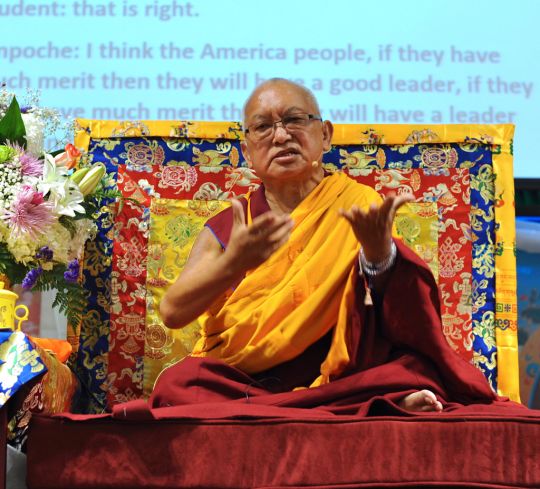
Lama Zopa Rinpoche teaching at the Light of the Path retreat in Black Mountain, North Carolina, US, August 2016. Photo by Ven. Lobsang Sherab.
More than 300 people are attending the 2016 Light of the Path retreat with Lama Zopa Rinpoche, currently taking place in North Carolina, US, now in its second week. In addition, many more people are watching Rinpoche teach live in English on YouTube with simultaneous interpretation into French, Spanish and Italian. Access to the live transcript in English is now available. Audio of Mandarin interpretation is also available. (More details on the live video and live transcript below.)
Of the 300 students in attendance more than 40 are ordained Sangha. In addition, many are long-time students and center directors and spiritual program coordinators. There are students from many FPMT centers in various countries including Australia, Canada, Colombia, France, Germany, Italy, Malaysia, Mexico, Nepal, the Netherlands, New Zealand, Singapore, Spain, Switzerland and the UK. This is the fourth year of the Light of the Path retreat. The root text for the retreat is Lama Atisha’s Lamp for the Path to Enlightenment.
Retreat organizers from Kadampa Center, located in Raleigh, a four-hour drive away, and volunteers have transformed the auditorium of a YMCA conference and retreat center into a Tibetan gompa with 21 Tara statues and an extensive altar, creating a wonderful environment for Rinpoche’s teachings.
So far, Rinpoche has yet to teach on the root text. Instead, Rinpoche has gone over the benefits of taking the eight Mahayana precepts on a number of days and gave the precepts early on so people could receive the lineage. In addition to doing precepts daily, Lama Chöpa is also being preformed daily. On one day, Rinpoche dedicated Lama Chöpa tsog to the quick return of one of Rinpoche’s gurus – Geshe Lhundup Sopa Rinpoche, who passed away two years ago.
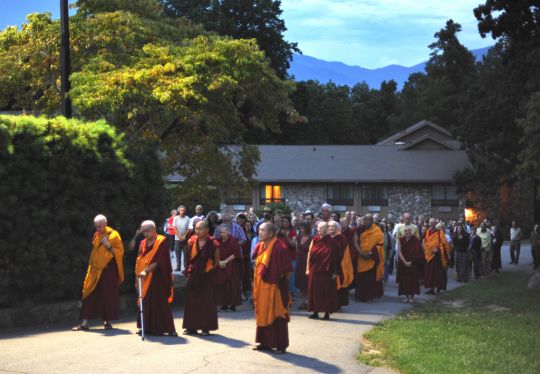
Lama Zopa Rinpoche leading students in a walking meditation at the Light of the Path Retreat, North Carolina, US, August 2016. Photo by Ven. Lobsang Sherab.
Rinpoche has also talked about the benefits of prostrations, which were covered in two sessions, and has explained two different ways to do walking meditation based on lam-rim meditations, such as walking while thinking about the incredible kindness of sentient beings. Silence is being observed from after the last teaching session in the evening until lunch on the following day.
According to Ven. Holly Ansett, the retreat has been organized extremely well by Kadampa Center. And the retreat venue, located in the Blue Ridge Mountains of North Carolina, is very comfortable as well as being very beautiful and peaceful. Geshe Gelek, of Kadampa Center, has ensured that Rinpoche and all the retreatants are being well cared for by the team from Kadampa Center.
Ven. Holly also notes how missed Ven. Thubten Kunsang is at the retreat. For many years Ven. Kunsang, who passed away in July, was a familiar smiling face at retreats with Rinpoche, where he would record the audio of Rinpoche’s teachings and take photos. Rinpoche began this year’s retreat reminding students of impermanence and how anyone could die at any time.
The media team for the retreat has done amazing work setting up the live video streaming of the teachings and taking care of all the technical needs at the venue. Ven. Joan Nicell’s live transcription of the teachings is projected on a screen above Rinpoche and also is now viewable on FPMT’s YouTube channel.
Summary of links to video and audio options for the Light of the Path 2016 teachings:
YouTube live video stream of teachings with links to interpretation in English, Français, Español and Italiano:
https://www.youtube.com/user/FPMTinc
NEW! Live English transcription of Lama Zopa Rinpoche’s teachings (can be opened in a second window and watched along side the live teaching):
https://www.youtube.com/c/fpmtinc/live
Mandarin interpretation of teachings (audio only):
http://en.1000mikes.com/show/fpmtlopchinese_on_air
Backup Livestream video (in English) with occasional updates on schedule:
http://livestream.com/FPMT/LOP2016
Facebook Live video on Lama Zopa Rinpoche’s Facebook page:
https://www.facebook.com/lamazoparinpoche
Recorded video, audio and transcripts of the Light of the Path teachings will be posted here as they become available:
https://fpmt.org/media/streaming/teachings-of-lama-zopa-rinpoche/light-of-the-path-teachings-2016/
Many additional resources and materials have been developed from the previous precious retreat teachings:
- All teachings from the 2009, 2010 and 2014 are available on the FPMT Online Learning Center.
- Together with many additional resources, the Living in the Path online program has been created from the Light of the Path retreat teachings. Organized into structured modules, you will find this program on the FPMT Online Learning Center.
More information, photos and updates about FPMT spiritual director Lama Zopa Rinpoche can be found on Rinpoche’s webpage on FPMT.org. If you’d like to receive news of Lama Zopa Rinpoche and FPMT via email, sign up to FPMT News.
17
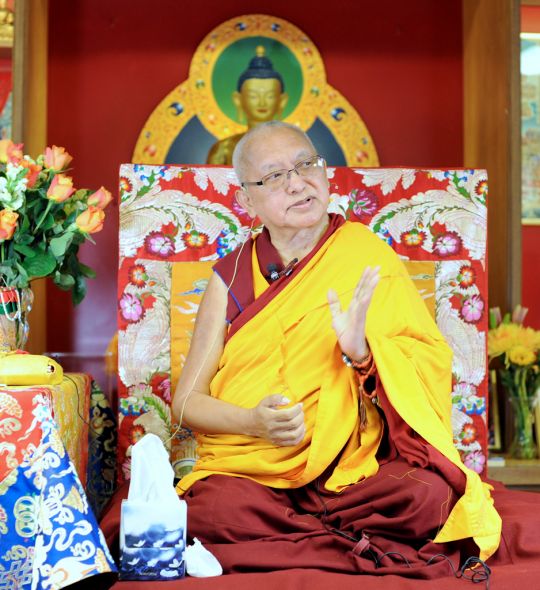
Lama Zopa Rinpoche teaching at Kadampa Center in Raleigh, North Carolina, US, before the beginning of the Light of the Path retreat, August 13, 2016. Photo by Ven. Lobsang Sherab.
The Light of the Path retreat is underway. Live video of Lama Zopa Rinpoche teaching in English with interpretation into French, Spanish and Italian is now available! Live Mandarin interpretation is available in audio only. A second, backup, Livestream.com video stream of the teachings in English is available in case of technical difficulties. This link also will have occasional updates on the teaching schedule. A third video stream is available via Facebook Live at Lama Zopa Rinpoche’s Facebook page.
The retreat began on Sunday, August 14, at 5 p.m. local time (UTC -5) and is the fourth in a series of teaching retreats led by Rinpoche based on Lama Atisha’s text Lamp for the Path to Enlightenment. It concludes on August 28 and is taking place at the YMCA Blue Ridge Assembly in rural Black Mountain, North Carolina, United States. Kadampa Center, located in Raleigh, North Carolina, organized the retreat.
Even if you miss the live streamed teachings, all video and audio recordings of the 2016 teachings, as well as transcripts, will be available on the “Rinpoche Available Now” page on FPMT.org soon after.
Summary of links to video and audio options for the Light of the Path 2016 teachings:
YouTube live video stream of teachings with links to interpretation in English, Français, Español and Italiano:
https://www.youtube.com/user/FPMTinc
Mandarin interpretation of teachings (audio only):
http://en.1000mikes.com/show/fpmtlopchinese_on_air
Backup Livestream video (in English) with occasional updates on schedule:
http://livestream.com/FPMT/LOP2016
Facebook Live video on Lama Zopa Rinpoche’s Facebook page:
https://www.facebook.com/lamazoparinpoche
Recorded video, audio and transcripts of the Light of the Path teachings will be posted here as they become available:
https://fpmt.org/media/streaming/teachings-of-lama-zopa-rinpoche/light-of-the-path-teachings-2016/
Many additional resources and materials have been developed from the previous precious retreat teachings:
- All teachings from the 2009, 2010 and 2014 are available on the FPMT Online Learning Center.
- Together with many additional resources, the Living in the Path online program has been created from the Light of the Path retreat teachings. Organized into structured modules, you will find this program on the FPMT Online Learning Center.
More information, photos and updates about FPMT spiritual director Lama Zopa Rinpoche can be found on Rinpoche’s webpage on FPMT.org. If you’d like to receive news of Lama Zopa Rinpoche and FPMT via email, sign up to FPMT News.
17
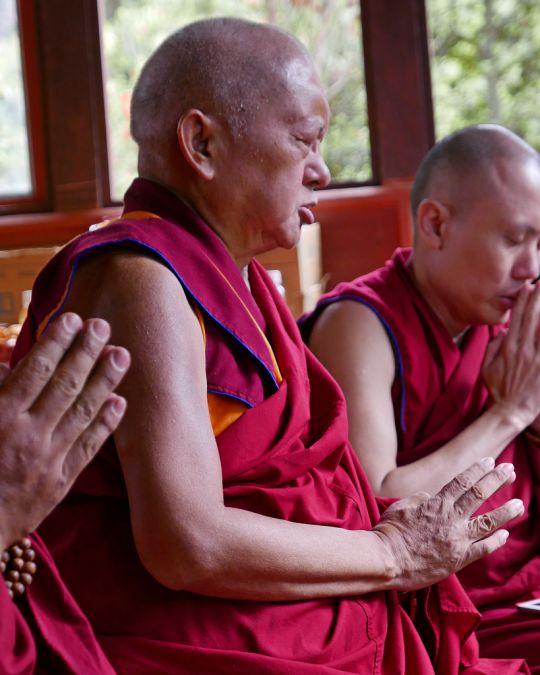
Lama Zopa Rinpoche doing puja at a stop on the way to Taktsang (Tiger’s Nest) Monastery, Bhutan, May 2016. Photo by Ven. Roger Kunsang.
“Anybody who wants peace in the world should read the Golden Light Sutra (Ser.ö dam.päi do wang.gyi gyälpo,” Lama Zopa Rinpoche advised in 2007. “This is a very important practice to stop violence and wars in the world. The Golden Light Sutra is one of the most beneficial ways to bring peace. This is something that everyone can do, no matter how busy you are, even if you can read one page a day, or a few lines and in this way continually read the Golden Light Sutra.”
“The holy Golden Light Sutra is the king of the sutras. It is extremely powerful and fulfills all one’s wishes, as well as bringing peace and happiness for all sentient beings, up to enlightenment. It is also extremely powerful for world peace, for your own protection and for the protection of the country and the world. Also, it has great healing power for people in the country.
“For anyone who desires peace for themselves and for others this is the spiritual, or Dharma, way to bring peace that doesn’t require you to harm others, doesn’t require you to criticize others or even to demonstrate against others, yet can accomplish peace. Anyone can read this text, Buddhists and even non-Buddhists who desire world peace.
“This also protects individuals and the country from what are labeled natural disasters of the wind element, fire element, earth element and water element, such as earthquakes, floods, cyclones, fires, tornadoes, etc. They are not natural because they come from causes and conditions that make dangers happen. They come from past inner negative thoughts and actions of people, and from external conditions. …”
Read the complete advice from Rinpoche on the Sutra of Golden Light and visit FPMT.org’s page on the Sutra of Golden Light, where you can receive the oral transmission of the sutra via video and download audio recordings of the sutra as well as find the sutra text in 14 different languages:
https://fpmt.org/education/prayers-and-practice-materials/sutras/golden-light-sutra/
More information, photos and updates about FPMT spiritual director Lama Zopa Rinpoche can be found on Rinpoche’s webpage on FPMT.org, including post on Rinpoche’s recent trip to Bhutan.
If you’d like to receive news of Lama Zopa Rinpoche and FPMT via email, sign up to FPMT News.
Watch Lama Zopa Rinpoche teach live at the Light of the Path Retreat in August 2016 on FPMT’s YouTube channel. Streaming will be available in English, French, Spanish, Italian and Danish. Backup live streaming in English will also be available on Livestream.com. All video and audio recordings of the 2016 teachings, as well as transcripts, will be made available on the “Rinpoche Available Now” page on FPMT.org soon after the teaching
- Tagged: lama zopa rinpoche
- 0
- Home
- News/Media
- Study & Practice
- About FPMT Education Services
- Latest News
- Programs
- New to Buddhism?
- Buddhist Mind Science: Activating Your Potential
- Heart Advice for Death and Dying
- Discovering Buddhism
- Living in the Path
- Exploring Buddhism
- FPMT Basic Program
- FPMT Masters Program
- FPMT In-Depth Meditation Training
- Maitripa College
- Lotsawa Rinchen Zangpo Translator Program
- Universal Education for Compassion & Wisdom
- Online Learning Center
- Prayers & Practice Materials
- Overview of Prayers & Practices
- Full Catalogue of Prayers & Practice Materials
- Explore Popular Topics
- Benefiting Animals
- Chenrezig Resources
- Death & Dying Resources
- Lama Chopa (Guru Puja)
- Lama Zopa Rinpoche: Compendium of Precious Instructions
- Lama Zopa Rinpoche: Life Practice Advice
- Lama Zopa Rinpoche Practice Series
- Lamrim Resources
- Mantras
- Prayer Book Updates
- Purification Practices
- Sutras
- Thought Transformation (Lojong)
- Audio Materials
- Dharma Dates – Tibetan Calendar
- Translation Services
- Publishing Services
- Teachings and Advice
- Find Teachings and Advice
- Lama Zopa Rinpoche Advice Page
- Lama Zopa Rinpoche: Compendium of Precious Instructions
- Lama Zopa Rinpoche Video Teachings
- ༧སྐྱབས་རྗེ་བཟོད་པ་རིན་པོ་ཆེ་མཆོག་ནས་སྩལ་བའི་བཀའ་སློབ་བརྙན་འཕྲིན།
- Podcasts
- Lama Yeshe Wisdom Archive
- Buddhism FAQ
- Dharma for Young People
- Resources on Holy Objects
- Ways to Offer Support
- Centers
- Affiliates Area
- Teachers
- Projects
- Charitable Projects
- Make a Donation
- Applying for Grants
- News about Projects
- Other Projects within FPMT
- Support International Office
- Projects Photo Galleries
- Give Where Most Needed
- FPMT
- Shop
Translate*
*powered by Google TranslateTranslation of pages on fpmt.org is performed by Google Translate, a third party service which FPMT has no control over. The service provides automated computer translations that are only an approximation of the websites' original content. The translations should not be considered exact and only used as a rough guide.Superficial observation of the sense world might lead you to believe that people’s problems are different, but if you check more deeply, you will see that fundamentally, they are the same. What makes people’s problems appear unique is their different interpretation of their experiences.
